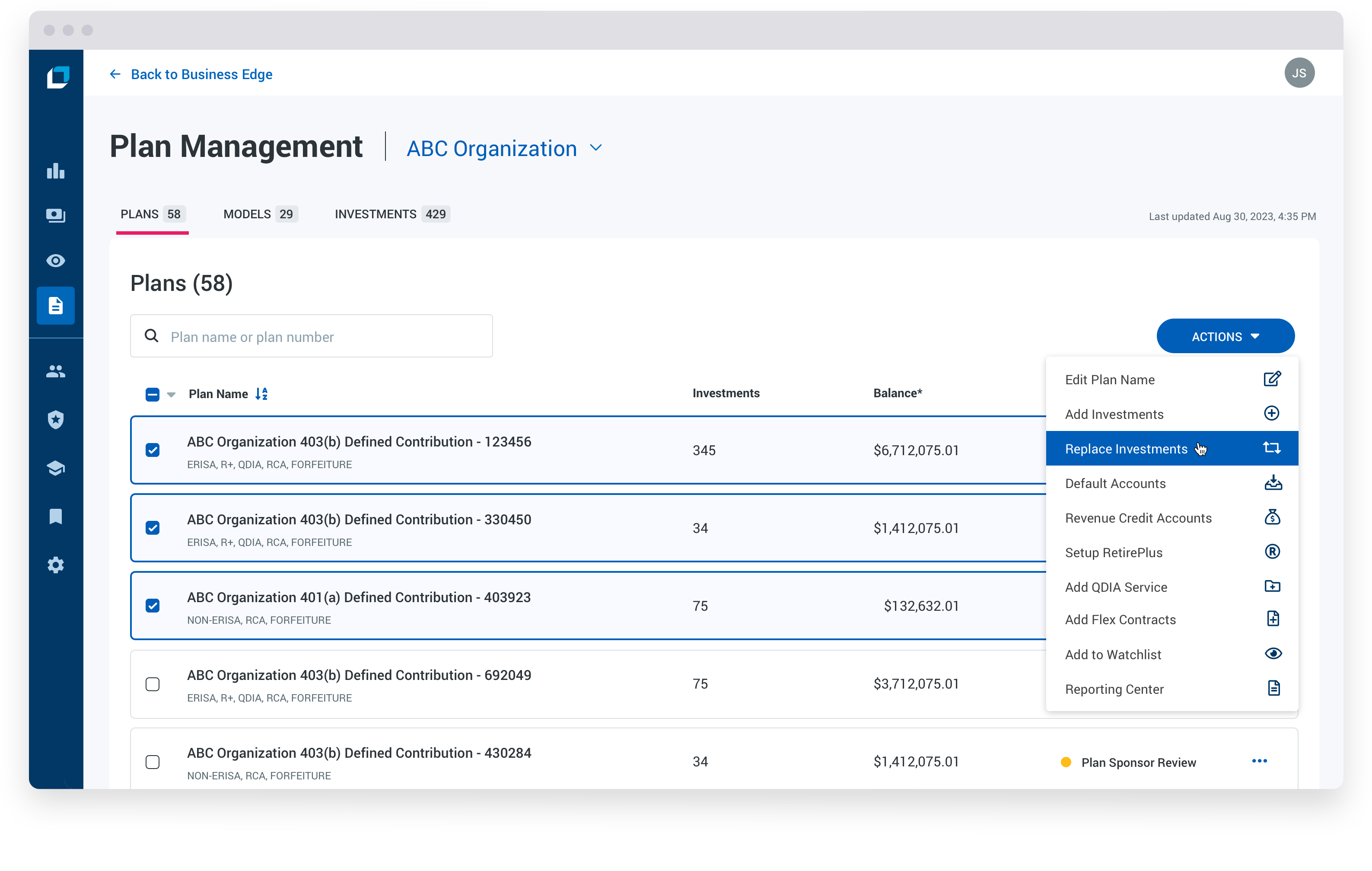Brand
TIAA
TIAA
Research
UI/UX Design
2023
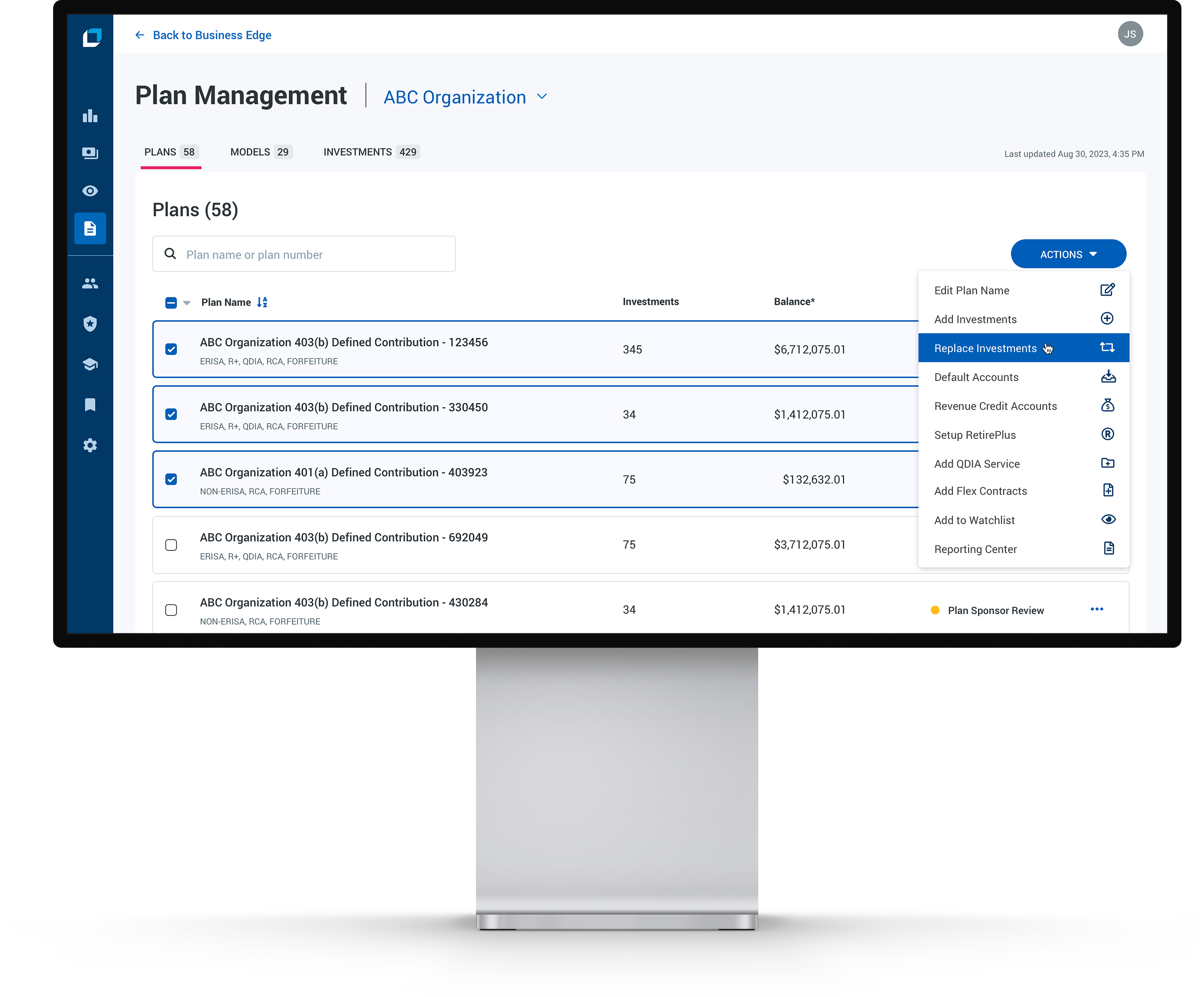
Currently, the process to update a fund lineup on more than one plan is very time consuming. Users must submit every plan change individually which makes the process extremely tedious, prone to error and hard to track when changing multiple plans at a time.
Allowing users to self service multiple plan changes with the same digital assets they use today (Business Edge and Plan Focus) and keeping them informed of the current status of their request will save users valuable time, reduce errors and create more transparency throughout the change request journey.
• Save time by bundling plan changes
• Set a single implementation date
• More transparency in status of request
• Ability to track request offline
• Consultant assigned to the request
• Improve client relations
• Increase user engagement
• Reduce requests by email
• Scalable rollout solution
• Reduce implementation time
There was a lot we needed to unpack for this project. Very little usability testing was done with the current state of the app and the feedback that we had to work with was from our own internal consultants. This was not going to work if we are to design an experience for third-party consultants and plan sponsors without any input from them.
I successfully championed for research and usability testing for the B2B space at TIAA and we finally had support from the B2C research team to facilitate user interviews and testing, moving more toward a true agile design process.
Working closely with the research team, we devised a plan to gather feedback on the current state of the app in a phased approach. This would include a new round of interviews and usability tests with our own internal consultants and more importantly, third-party consultants and plan sponsors.
During the first round of user interviews and usability testing, we discovered there was a lot wrong with the current state of the app. Consultants were confused as to why they were being prompted to interact with so many plan settings when all they needed to do was replace an investment in a plan. Plan sponsors on the other hand, were more concerned with contributions and reporting, and would rather leave the investment changes up to the consultant.
They also expressed dissatisfaction with the status updates. Both plan sponsors and consultants felt they were too vague and didn’t know who to contact when they wanted to check on the status of the change request.
Target Audience: Third-Party Consultants
Retirement Plan Consultants shared that 75-80% of the time plan change requests are coming from third-party consultants. Often, when the request is from the plan sponsor, it’s still driven by a consultant conversation, or the plan sponsor wants to make the request themselves to avoid a charge by the consultant, or the plan sponsor does not have a consultant.
Non-Proprietary Lineup Changes Are Requested More Often
Among the types of lineup changes, non-proprietary fund changes are requested more often than proprietary fund changes because they allow consultants a larger range of options. In addition, consultants are seen as unbiased when recommending non-proprietary funds.
Lineup Change Complexity is Driven by TIAA’s Operational Processes
From the customer’s side, the request process and identifying the funds for the change are simple (request emails are sent to the RPCs). The complexity is driven by the many teams and lengthy process that changes must go through within TIAA.
Providing Status Updates
Plan sponsors and consultants often reach out to RPCs to check the status on their lineup changes.
“For 6 weeks, even if everything is smooth, all we can tell the client is we’re going through our internal quality steps.” -TIAA Consultant
There was a lot that would need to be done in order to meet all of our users’ needs. At a minimum, we needed to provide a way for users to perform investments changes to more than one plan at a time. I collaborated with other designers, product managers, and dev leads and we looked at the entire lineup change experience in order to determine where in the flow we could fit bundling. There was a lot of back and forth due to the many constraints we had: back-end processes, business rules, level of effort from the dev team, scalability and our deadline for MVP.
With all of those considerations, the product owners decided that we would move forward with our recommendation of introducing bundling at the end of the lineup change before the request was submitted. I also demonstrated how this feature could scale moving forward when bundling would inevitably start at the beginning of the plan change flow. But that would require a considerable amount of time and resources from the dev team and would take several months of back-end reconfiguration to accommodate this new capability.
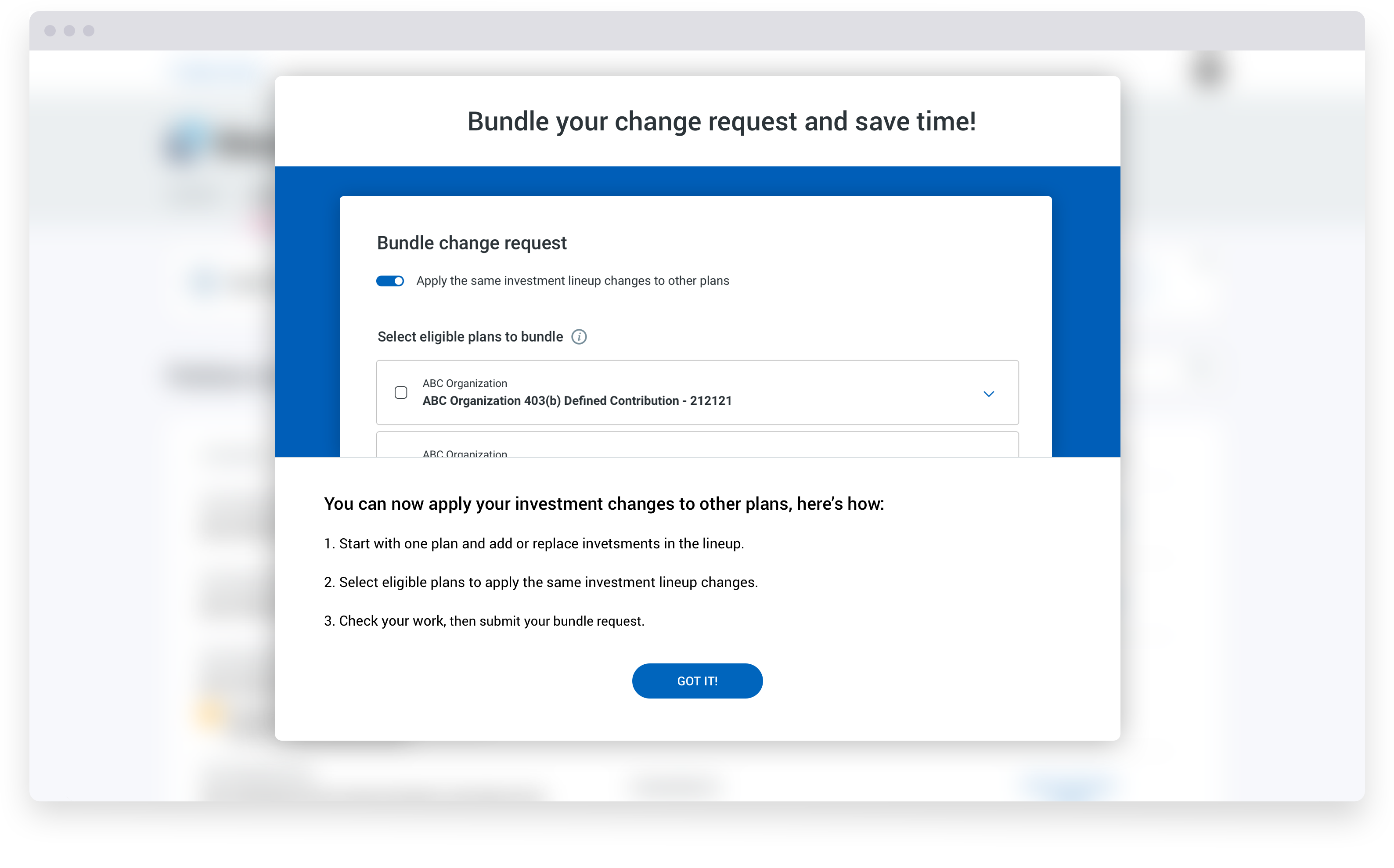
Announcing the new bundling feature when user logs in.
Requesting investment changes for a plan was business as usual. The user would still be able to perform plan changes as they normally would, but once they reached the review page, they would have the option to apply those same investment changes to other eligible plans. Eligibility for this particular release required that the plans have identical investment line ups, meaning every investment, contract, default and suspense accounts, and TIAA services had to be exactly the same. This was a technical limitation we had to work with.
It is fairly common for our clients/institutions to have multiple plan offerings with the exact same lineups. This is because the institution may have several locations or different departments or types of employees, but want to offer them the same retirement plan options. Because of this, often when a certain fund or investment is not performing well, it needs to be replaced in several plan offerings. This is where bundling plan changes would be extremely useful for a consultant.
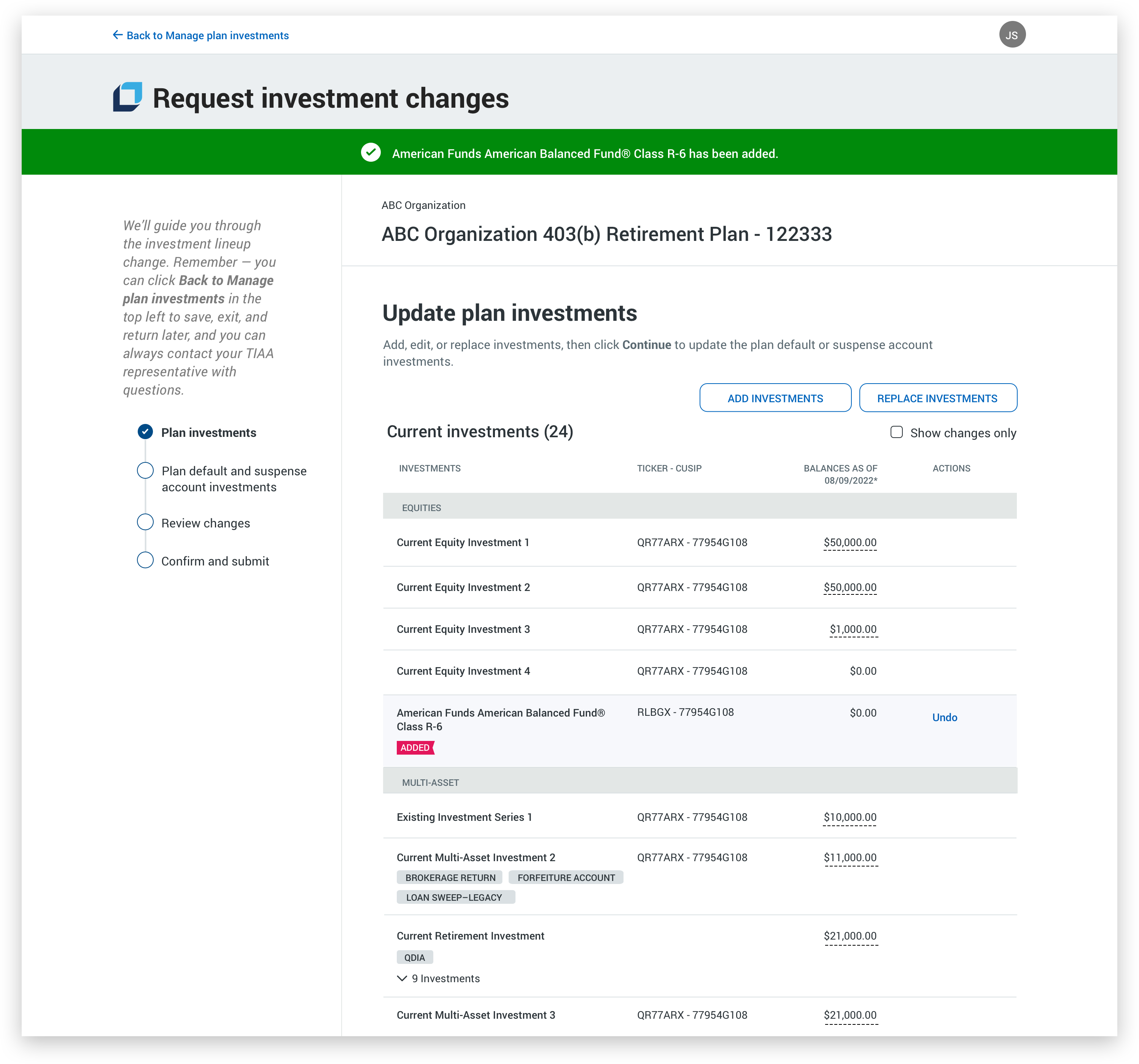
Performing investment changes is business as usual
The ability to bundle other plans with this request is presented to the user after they have performed the initial investment changes. This is due to the technical constraints and our very tight deadline. This feature could still be used in the future even when plan selected is at the beginning of a flow. For instance, a user may have forgotten to select a certain plan at the beginning and they would now have the option to include those plans at this step.


User has selected 2 eligible plans for bundling.
Users are now able to track their bundled change request in the Activity tab as one group instead of single entries.
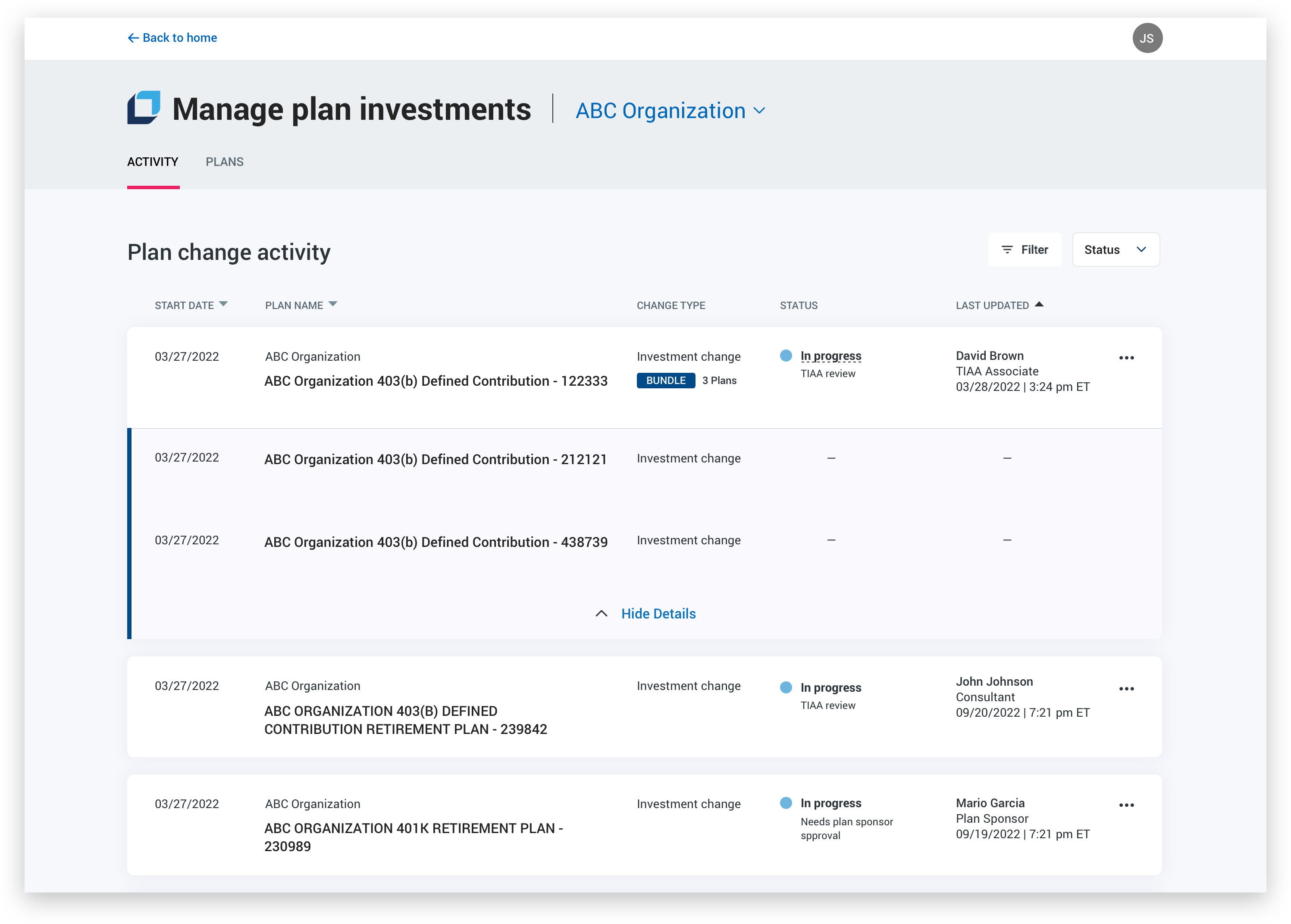
This is a net new feature that currently does not exist. My goal here was to incorporate the feedback that we got during from our research by giving the user more detailed information about the change request that was submitted. The addition of a Request ID would allow users to check the status of their request without having to log in to Plan Focus. I also included details such as the TIAA Consultant who is currently handling the request. This way a client will know exactly who to reach out to if needed.
Design leadership loved the idea and is looking to incorporate this design pattern in other lines of business and in the B2C space.
![]()
The feedback from our users and design leadership was extremely positive. Consultants felt the process was simple enough for them to use and stated they would be using this feature regularly as many of their investment changes often involve multiple plans.
Design leadership was very impressed with this simple and elegant solution given the technical constraints and timeline we had to work with and were happy to hear that this feature would scale and could be reused as we move forward with the next iteration of the investment lineup change tool.
Thinking ahead and based on the experience and feedback I had from our users, stakeholders, and product owners, I had started working on a concept for the next iteration of the investment lineup change tool. With this capability, users would be able to quickly select the plans they wanted to change and do so in one quick step without having to go through the entire lineup change journey.
This concept also incorporates a lot of familiar design patterns when using an inventory system such as the ability to select multiple items and perform bulk actions, making it feel much more intuitive without the need to have additional instructional content.
